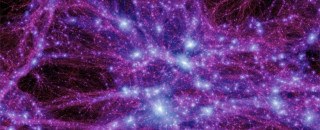Pearl Sandick is Finding the Light in Dark Matter
By Riley Black
Dark matter has a little bit of an image problem. On the face of it, the phrase might conjure up images of some form of sinister matter opposed to what we see around us, or something you might read about in a sci-fi novel. But the reality is far different. In fact, University of Utah astrophysicist Pearl Sandick says, it's a great thing that dark matter exists.
"Dark matter isn't scary!", Sandick notes. So far as researchers have been able to discern, dark matter has existed in the Universe for billions of years. In basic terms, dark matter is a component of the Universe that's detected by its effects of gravity rather than our ability to see it. Scientists estimate that about 27 percent of the Universe is dark matter, with visible matter - that is, everything we can see with our eyes - being a paltry half a percent by comparison. "We're really glad it's here," Sandick says, "because our galaxy wouldn't have been able to form, and life wouldn't exist as we know it, without dark matter."
Sandick's path to studying these fundamental aspects of the Universe started with an elementary school affinity for math, and an appreciation that persists today. That sustained interest led her to explore physics in college, eventually growing into a stellar career in particle physics - "the study of the smallest constituents of nature and how they behave, which is a puzzle we're still trying to explain." We certainly have some understanding of our Universe and what's in it, but, Sandick says, "we know there's more to it than our current model can explain."
The discovery of dark matter and its role in the universe is part of those outstanding puzzles. Even though earlier experts had some inklings about what we now call dark matter, it wasn't until about 1980 that physicists and astronomers began to fully realize the influence of dark matter and the questions it raised about the nature of the Universe. There's far more that's presently unknown about the phenomenon than what's known.
Little drives science like a compelling mystery, though, and researchers are learning ever more about the harder-to-detect parts of the Universe. "We've made progress in leaps and bounds," Sandick says. Not only has there been tremendous progress on the theory side, she notes, but methods of detecting new particles like dark matter have improved to the point where experts are now testing some longstanding ideas and hypotheses about dark matter. Sandick is looking forward to what lies ahead. "Whether or not these new techniques finally detect dark matter, our understanding of what dark matter might be will undoubtedly change."
There is so much that's left to find. "Right now," Sandick says, "we are in the process of discovering the nature of dark matter." Considering how a great deal of the Universe is dark matter, understanding the details of this cryptic phenomenon has the potentially to significantly alter what we thought we knew and how we perceive everything around us. There's so much to be excited about in what lies ahead, Sandick says, as she and her colleagues shine a light on dark matter.
Dr. Pearl Sandick was a speaker in the 2022 Lecture Series. Click here to learn more about our upcoming Lecture Series here. Or, click here to read more about the 2022 Lecture Series.
Riley Black is the author of The Last Days of the Dinosaurs, Skeleton Keys, My Beloved Brontosaurus, and is a science writer for the Natural History Museum of Utah, a part of the University of Utah in Salt Lake City. Our mission is to illiminate the natural world and the place of humans within it. In addition to housing outstanding exhibits for the public, NHMU is a research museum. Learn more.
